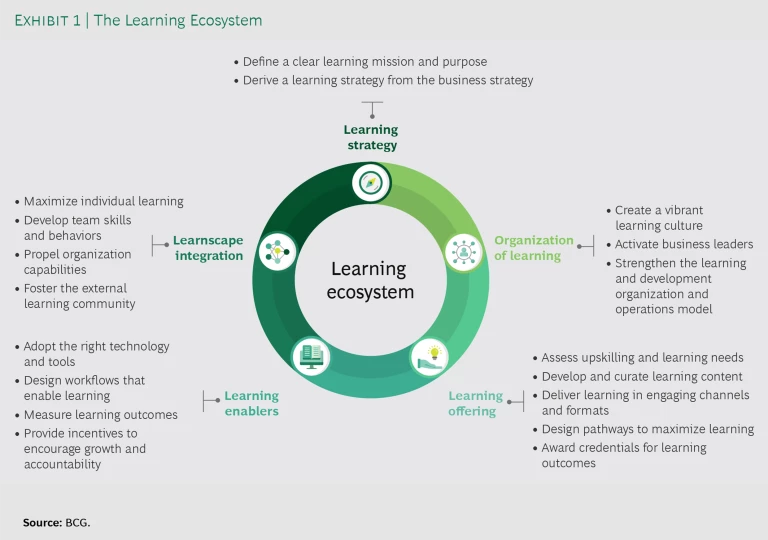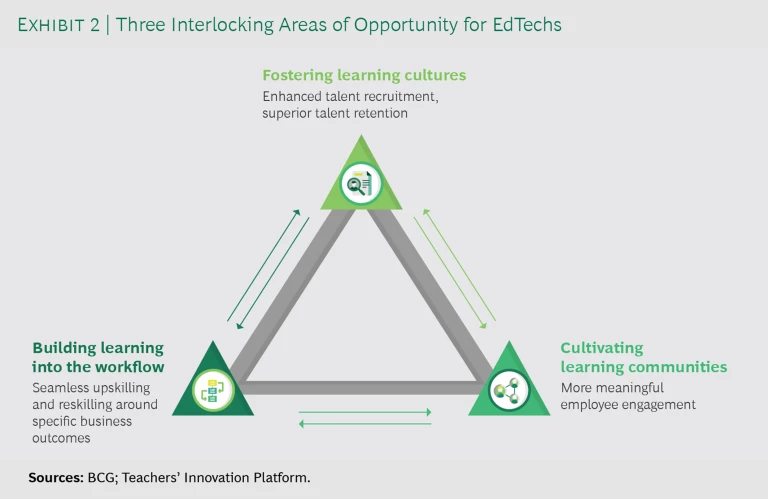At the start of 2020, many executives across industries were planning their digital transformations. While some felt trepidation about the challenges that these huge changes would pose, most expected they’d have five or ten years to lay the groundwork and make the switch. Then COVID-19 hit, compressing that transformation timeline and rapidly accelerating the need to educate and train workforces on the digital skills necessary for an array of new roles. In a recent BCG survey of some of the world’s biggest companies, about 95% of participants indicated that corporate learning is crucial to their future and should be a high priority.
Even before COVID-19, companies were adopting digital tools for corporate learning and development (L&D), with e-learning accounting for 40% of the $50 billion corporate L&D market in North America. With digital expected to play an even greater role after the pandemic, BCG and Teachers’ Innovation Platform (TIP), the venture capital division of Ontario Teachers’ Pension Plan, joined forces to learn how education technology (EdTech) could support advancements in corporate L&D. We interviewed more than 20 CEOs, EdTech experts, and venture capital investors to assess the opportunities for learning platforms to extend beyond the delivery of content and assessments. Specifically, these discussions helped us identify three interlocking areas of opportunity where EdTechs can support corporate partners: fostering learning cultures, cultivating learning communities, and building learning into the workflow.
Widespread Workforce Disruption
Over the next ten years, more than a billion jobs will be reconfigured, creating enormous changes for workers. The pandemic will drive some of this, but equally important will be the longer-term impact of digital transformation and globalization. BCG and TIP estimate that the average “half-life” of job skills is less than five years and that 60% of all talent will need to be upskilled in the next five years as new digital skills (such as software coding, data analytics, and the use of next-generation sales software) are needed for new digital jobs (including data visualizers, genetic counselors, and virtual reality designers).
Companies have a vested interest in making educational resources as widely accessible and affordable as possible.
As companies continue to automate, rethink their cost structure, and aspire to become digital-first, they have a vested interest in making educational resources as widely accessible and affordable as possible—to their own employees as well as to the unemployed and underemployed in order to increase the pool of potential job candidates. As Amy Golding, CEO, Opus Talent Solutions, puts it: “Talent shortages are huge and growing. COVID-19 has only amplified this problem as many enterprises are seeking to fill their five-year digital transformation job vacancies in one year. EdTechs are going to play an important role in filling the supply gap.”
The Rise of Learning Ecosystems
Until recently, EdTechs operating in the B2B space focused mostly on:
- Providing skills development, such as online and on-demand content for short-form credentialing
- Helping learners track credentials, demonstrate skills to employers, and apply for jobs
- Bridging the needs of employers and employees by offering upskilling, coaching, and advice to workers and by helping companies recruit talent with highly sought-after skills
Top companies are now looking beyond skills development to embed learning into their day-to-day activities and long-term strategy. Where this is working, the C-suite is pushing the agenda. These senior leaders understand that for companies to build a competitive advantage, employees must be constantly learning, adapting, and acquiring an evolving set of skills. Because the development of these learning ecosystems is very complex, EdTechs have a unique opportunity to help their enterprise partners transform into full-fledged learning organizations. (See Exhibit 1.)
Three EdTech Opportunities
We see three interlocking areas of opportunity for EdTechs: fostering learning cultures, cultivating learning communities, and building learning into the workflow. All three reinforce one another. (See Exhibit 2.) Companies that promote strong learning cultures are more likely to attract and retain diverse talent—and encourage the cross-pollination of skills within learning communities. Meanwhile, the emergence of learning communities helps to incorporate learning into daily workflows and changes managers from taskmasters to coaches and facilitators. All these activities create a virtuous cycle that continually reinforces an organization’s L&D. EdTechs that facilitate this cycle will have a unique chance to integrate themselves into the learning fabric of their partners.
Fostering Learning Cultures
We believe that EdTechs have an opportunity to help customers build full-fledged learning cultures. To be clear, EdTech companies cannot, on their own, establish learning cultures for their enterprise partners. But they can provide assistance by, for example, facilitating training and outreach to new recruits, creating learning roadmaps for employees, developing learning contracts between employees and talent managers, and monitoring performance and outcomes.
Workers value learning cultures, and a strong learning culture can improve a company’s ability to nurture, attract, and retain employees. Indeed, job candidates give considerable weight to the availability of L&D when considering a position. For this reason, “there’s a real opportunity for companies competing for talent to partner with EdTechs to provide training modules for university students to demonstrate their L&D culture, get a better sense of the students’ commitment and skills, and enable these students to be more successful on day 1 of the job,” says Tim Brady, partner, Y Combinator.
To win C-suite support for these efforts, it’s critical to show ROI and prove value by monitoring the performance and outcomes of the learning culture. Current metrics are admittedly limited, according to Pierre Dubuc, co-founder and CEO, OpenClassrooms. Most employers and companies focus on tracking the number of people enrolled, completion rates, credentials, job placement, and learning satisfaction. But going forward, he says, companies will need to track whether new skills and competencies help employees move into new jobs and how well employees perform in those new positions.
“There is a big opportunity for EdTech to enable enterprises to build learning cultures, but for EdTech to evolve into this role, it needs to look beyond digitizing content for online use,” says Stephen Jones, founder and CEO, Vivovii. “It needs to connect the strategic imperatives of the C-suite to the execution capabilities of the workforce by providing instant, easy access to useful content and tools that are related to accomplishing ‘real work.’ This is especially true for developing soft skills, including leadership skills, that Big Rock (in other words, outsized) execution priorities require and that EdTech otherwise leaves wanting.”
Cultivating Learning Communities
The learning culture is enriched when strong learning communities exist within an organization. Given that workforces are increasingly remote and many digital projects require talent drawn from across the organization to work as an integrated team, these social communities are more essential than ever. And COVID-19 has reinforced their importance. According to BCG’s separately conducted employee sentiment survey, employees who reported satisfaction with their social connectivity to colleagues are two to three times more likely to have maintained or improved their productivity on collaborative tasks during the pandemic than those who are dissatisfied with their connections.
Connie Chan, general partner, Andreessen Horowitz, says, “We’re beginning to see more EdTech models that harness technology to make learning increasingly interactive and community driven. These solutions invite people to participate across geographies, support additional learning not contained in curricula, and help foster deeper social connection—much-needed solutions in a work environment that is increasingly remote and fragmented.”
With this in mind, EdTech companies should incorporate more dynamic, peer-to-peer (P2P) functions into their platforms in order to help corporate partners cultivate learning communities and build more social cohesion. Some examples include facilitating mentor-mentee relationships and apprenticeships, creating immersive learning experiences for employees to cocreate (such as forums for peer debate, feedback, and group work), and building dynamic social networks by developing or integrating with existing digital teaming platforms and social networks within the workplace. John Danner, managing partner, Dunce Capital, predicts that in the future learning communities “will essentially become real-time social networks that allow for live collaboration between learners.”
These P2P functions are particularly critical in developing the soft skills that a digital enterprise needs, such as empathy and communication (as opposed to hard skills like data analytics and digital literacy). “Currently, many EdTechs are focused on hard skills. However, we see a big opportunity for EdTechs to create more social, interactive, engaging community-building experiences. This will also enable more social and emotional learning experiences,” says Amit Mukherjee, partner, New Enterprise Associates.
Building Learning into the Workflow
A major challenge that companies face today is understanding and cataloguing the capabilities necessary to carry out all the jobs within the organization, the existing employees who possess those skills, where gaps exist, and how to close those gaps efficiently. We envision a future where EdTech platforms will help companies map the capabilities required to complete different tasks and track the skills of employees and their learning progression.
“Skill mapping the organization is a terrific concept, particularly because it connects directly with the recruitment and management of human capital,” says Victor Hu, managing partner, Lumos Capital Group. “A big part of enduring success for an enterprise is hiring agility and helping talent managers figure out how to put the right people in the right places. Right now, we don’t have a real-time view, not even close, to what people in an organization actually know.”
To achieve this vision of the future, employers need to go beyond the technology—they also need to make learning a core part of the individual’s job; this means creating the time and space for employees to engage in continuous learning. Managers can orchestrate more deliberate and reflective practices, including routine check-ins, to better embed on-the-job learning into the rhythms and routines of each employee’s workflow. This includes encouraging staff to dedicate some work time explicitly to learning; learning should be intertwined with work as much and as often as possible.
As part of this continuous learning, EdTech platforms need to curate the right content from the right sources (such as experts, mentors, and peers) so that lessons are delivered seamlessly and in an engaging manner—in the form of augmented-reality-based training, microlearning, and gaming, for example. One goal should be to connect employees immediately to resources or experts when new or unknown tasks arise during the course of the workday (rather than learning about new tasks and skills in a classroom or offline). Admittedly, building systems capable of this level of analysis and curation, and nudging employees to make use of these resources, is difficult and something of a stretch goal. “We’re behind here,” says Rebecca Kaden, managing partner, Union Square Ventures. “There aren’t a lot of digital tools institutionalizing and creating access to knowledge.”
Evidence suggests that pushing content in this manner improves learning outcomes (because lessons are applied immediately and better internalized) as well as productivity (since employees get the tools and resources precisely when they need them). By incorporating learning into the workflow and training the workforce “on the go,” companies also avoid relying on employees to educate themselves and acquire new skills on their own. “In the future, digital tools will serve as the ‘brains’ of organizations: storying and surfacing knowledge to the right people at the right time,” Kaden says.
When learning is happening all the time in a seamless way, learning cultures develop and learning communities become more active and engaging.
Enterprises might balk at allocating a large share of time to learning at work, but programs such as Google’s Innovation Time Off, which devotes a percentage of employees’ time to work projects of their own interest, have shown increased productivity and innovation. Further, the specific percentage of time allocated to learning is less important than the deliberate mutual effort by employees and managers to build learning into the workflow wherever possible. Some might argue that, in an ideal world, people are learning 100% of the time if they are really pushing themselves. When learning is happening all the time in a seamless way, learning cultures develop and learning communities become more active and engaging, creating a virtuous cycle that reinforces workflow learning.
“Workflow learning is the dream! Offering unique development opportunities to learners as they come up in the workday will completely change the learning experience and fundamentally improve workplace performance. There is a lot of potential here, and a lot of folks will try to crack this,” says Zach Sims, CEO & co-founder, Codecademy.
The Road Ahead
Building world-class learning capabilities is incredibly complex, and organizations and EdTechs need to work together to bring them to fruition. They have much to gain from the effort. To attract top talent, companies need to create cultures that embrace learning. Those that do this well will build strong learning communities. And these communities, together with a step change in skill mapping and advanced analytics, will pave the way for workflow learning and, more broadly, greater social cohesion within the organization. EdTechs that facilitate the development of this powerful set of reinforcing capabilities will integrate themselves into the learning fabric of their partners.
With $200+ billion in net assets, the Ontario Teachers’ Pension Plan (OTPP) is the largest single-profession pension plan in Canada. Teachers’ Innovation Platform (TIP) is OTPP’s venture capital group. TIP focuses on late-stage venture and growth equity investments in companies that use technology to disrupt incumbents and create new sectors. TIP seeks to access significant global opportunities for investment in new businesses and sectors that are emerging as a result of unprecedented technological change.








